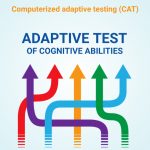PERSONALITY QUESTIONNAIRES

PHOTO 5
Personality questionnaires are one of the ways to measure personality – it’s certainly the most common way, but not the only way. As part of the project and with the cooperation of professors from the Department of Psychology, from the Faculty of Humanities and Social Sciences at the University of Zagreb, Photo 5 was created as an instrument that captures in an original and innovative way what psychologists traditionally measure with questionnaires. When we talk about the Photo 5 test, we are talking about a set of 50 photos, which was selected based on professional research work, with the aim of measuring five major personality dimensions (conscientiousness, openness, agreeableness, extraversion, and emotional stability). The structure of this instrument relies on the Five-Factor model, using the photographs as the material to provide a measure more appropriate to a dynamic, international, and multilingual labor market, as well as to be more resilient to socially desirable responses. From the very initial phase, until the final structure of the instrument, photographs were evaluated several times and those that did not meet the required criteria were successively removed from those that did not fit the factors of the criteria. After validation of the research was performed, the final result indicated Photo 5 to be a psychometrically valid and practical instrument that can greatly contribute to assessments in the organizational context and serve as a valuable supplement or a replacement to existing personality assessment questionnaire methods.
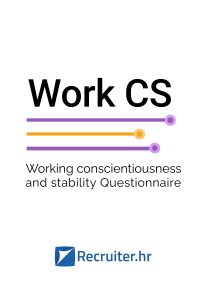

WORKING CONSCIENTIOUSNESS AND STABILITY
The Working Conscientiousness and Stability questionnaire was derived from long-term practice in organizational psychology. Based on experiences in a large number of professional selections of candidates for employment, relying on a scientific approach and the findings of multiple data analyses, an instrument was constructed that, through a small number of statements (61), captures a number of highly relevant features within the professional and organizational environment. In practice, it proved to be an extremely valuable control questionnaire and a precise instrument for checking some of the most important aspects of personality that show their importance in selection situations. Its good characteristics, precision and simplicity make it one of the indispensable instruments in the online.selekcija.hr system. Because of the dimensions it measures (resistance to stress, along with the sub-dimensions of emotional adjustment and stress control, perfectionism, tolerance for messiness, leadership, and control of others) and because of the way it measures it and the quality of the findings it provides, it is part of numerous test batteries used in organizational assessments.
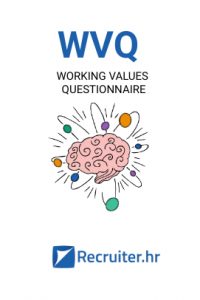

WORKING VALUES QUESTIONNAIRE
The Working Values Questionnaire (WVQ) is intended to assess candidates applying for a number of different positions. It consists of a set of self-assessment statements based on which a profile of the individual is ultimately created, with the most important information about their personality. The questionnaire is based on the widely accepted five-factor model of personality, excluding the measure of Openness to experience, while putting more emphasis on the other four dimensions. In organizational psychology, we traditionally assess how conscientious a person is at work, how proactive, stress-resistant, and pleasant they are in approaching people. In other words, it is often important to us, for a number of different work positions, to know in which terms we could describe the thoroughness or perseverance of an individual, their ability to control impulses, their level of readiness to involve themselves in various work activities, initiative in work, tendency to establish and maintain contact with colleagues and the like. Through years of work and research, psychologists have included these features in the Working Values Questionnaire, which, as a simple and comprehensive instrument, has proven to be applicable both in situations of evaluating candidates for lower and middle positions, as well as when evaluating leading personnel.
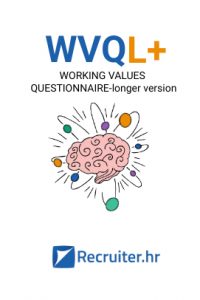

WORKING VALUES QUESTIONNAIRE LONG +
Although the Working Values Questionnaire in most cases in the organizational context represents an adequate measure for an individual’s personality, offering some of the most important information, in certain situations it is useful to assess some additional traits as well. Since more responsible positions imply more risks, a somewhat more comprehensive assessment is recommended. In addition to the other instruments, the assessment of candidates in higher positions can be supplemented with a longer version of the Working Values Questionnaire (WVQL or WVQL+), which also provide a more detailed picture of the person. A series of additional statements that include longer versions, ensures a more accurate and safer assessment of the candidate. The Working Values Questionnaire Long covers the aspects of boldness in performance, organization, compliance with rules and mistrust, while the longest version, the Working Values Questionnaire Long +, adds a scale indicating the tendency to provide socially desirable answers. With the information about the aspects of the four major dimensions of personality, these instruments, therefore, provide additional descriptions, which can represent key data and the basis of the assessment process itself. Due to its comprehensiveness and usefulness in the selection environment, the Working Values Questionnaire Long (+) has become one of the standard instruments of the most commonly used batteries in the selection processes.
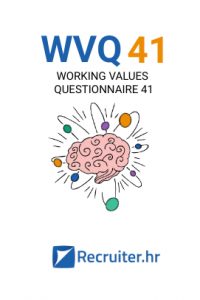

WORKING VALUES QUESTIONNAIRE 41
In rare selection situations, when there are significant time limits for testing or candidates (especially those with less education) emphasize their dislike for any testing and easily give up filling out extensive questionnaires, it is useful to use a short instrument. Likewise, with all other business requirements, HR professionals are often forced to “shortcut” tests and quickly assess candidates. In such situations of quick assessment of lower staff, the short version of the Working Values Questionnaire (WVQ41) proved to be particularly useful. It is an instrument developed as a quick measure of some of the most important traits in selection processes. Through only 41 statements, it covers the fundamental features and provides relevant information about the personality of individuals, trying to save their time as much as possible.
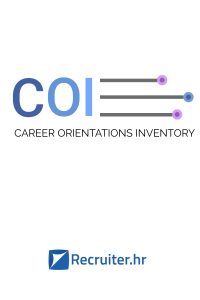

CAREER ORIENTATIONS INVENTORY
This instrument is designed as a short and quick measure of an individual’s dominant motives, needs and career goals. It is useful in various assessments because it provides information about the tendencies, preferences, and values that a person has and expresses in a professional context. Knowing such information can facilitate the career development of an individual and enable the creation of more efficient human resources management procedures. With a series of statements, the questionnaire describes the individual, offering an account of their more or less emphasized professional styles. For example, it is useful to know whether a person’s primary emphasis is on executive management or whether security and job stability are more important to them. An overview of the expression of certain professional styles enables the creation of a more precise picture of an individual in a professional context and an understanding of their aspirations and preferences.
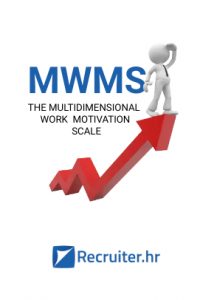

THE MULTIDIMENSIONAL WORK MOTIVATION SCALE
Within the framework of the theory of self-determination, a reliable and valid instrument applicable to the identification of the level and quality of an individual’s motivation for work has been developed. It is the Multidimensional Work Motivation Scale, which uses 19 statements to specify three main categories of motivation: amotivation, intrinsic and extrinsic motivation. The construction of the instrument was guided by the idea of overcoming the psychometric problems detected in previously developed scales, and the validation of this scale was carried out within the framework of research in several countries, with applications of the scale translated into several world languages. Precisely because of its good psychometric properties and quick and simple application, the scale has generally proven to be useful for examining the motivation of individuals in an organizational/work context.
TESTS FROM OUR PARTNERS
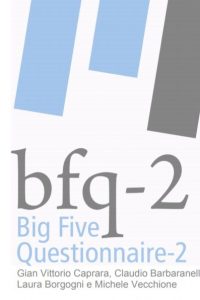

BIG FIVE QUESTIONNAIRE-2
The big five personality dimensions questionnaire is an extremely valuable and practically indispensable instrument in (organizational) psychology. The second, revised and refined version of a well-known and widely used instrument provides a description of an individual’s personality profile, in accordance with a taxonomy accepted by the scientific community. The popularity of this instrument is justified by its good psychometric characteristics, but also by its practical validity. Knowing the degree to which a person expresses the traits of extraversion, agreeableness, conscientiousness, emotional stability, and openness, greatly facilitates the understanding of their behavior and the ability to predict important outcomes and expectations. Information about these broad personality traits (supplemented by achievements on individual subdimensions) is useful in the context of assessments for different jobs. A comprehensive description of the main personality traits, as provided by the BFQ-2 instrument, is a kind of standard and basis of assessment. The BFQ-2 profile provides guidelines for further understanding of the compatibility of the individual’s characteristics with the position they are applying for, the tasks they perform or, for example, the potential and inclinations they have.
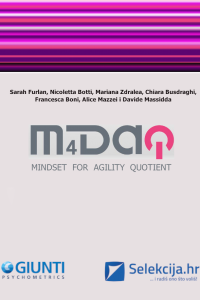

MINDSET FOR DIGITAL AGILITY QUOTIENT
The modern dynamic work environment and constant changes in the digital world, caused by advances in technology, are increasingly placing demands on individual flexibility. In this sense, the need to follow digital trends and develop skills (so-called soft skills) that are necessary for effective work in a digital context has become more accentuated. It is not about the skills of using new technologies, but about a set of different aspects that make it possible to work in an environment where managing uncertainty and the ability to continuously acquire new knowledge are necessary success factors. This instrument assesses several types of dexterity – cognitive, challenging, social and behavioral. This actually means that an effort is made to assess a person’s readiness for training with the purpose of adapting to a modern working environment. In addition, the test also measures a person’s willingness to participate in challenging activities that represent a test of their abilities and skills. In the framework of the assessment of social dexterity, the focus is placed on the individual’s tendency to pay attention to others and create a stimulating professional environment and develop feelings of belonging to the company. Behavioral dexterity, finally, covers the tendency to use technology in one’s private and professional life and to rely on the Internet as a source of knowledge and a way of forming one’s own professional digital identity. All these features contribute to understanding how a person functions in the (digital) world and reacts to changes and new circumstances.
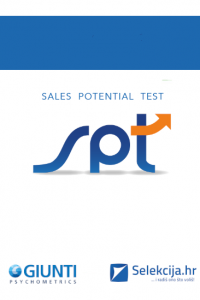

SALES POTENTIAL TEST
This is an instrument that primarily focuses on the dimensions that can determine success in a commercial context and in achieving top results. In order to indicate the sales potential of an individual, it measures certain personality traits (extraversion, conscientiousness, and emotional stability), two motivational orientations (results and status), and cognitive processes (internal locus of control, self-efficacy). In addition, it also offers information within the framework of a macro factor called the Sales Potential Index and includes a measure of the tendency to leave a positive impression. Its solution does not require special knowledge in the field of sales, but rather assesses the predispositions that enable success in sales positions. The questionnaire itself was developed based on the analysis of scientific literature, at the international level. It represents a useful measure in situations where knowledge of sales tendencies is a key aspect of the assessment itself.
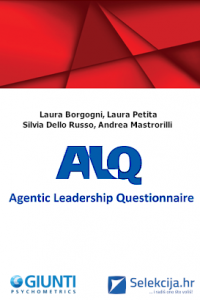

AGENTIC LEADERSHIP QUESTIONNAIRE
The ALQ is a questionnaire that shows its importance in the context of assessments within the organization, whether it is human resources management or organizational changes. It provides a detailed presentation of the leadership profile, thus offering an insight into the characteristic elements of a personal leadership style. It focuses on that part of the assessment that describes a person’s tendency to create and promote innovations that can lead to an organizational advantage. It emphasizes the aspect of action, i.e., the individual’s proactivity, the ability to initiate things and actively influence their environment and what is happening. The findings of this instrument describe multiple dimensions of management, recognizing the difference between managing people, activities, and oneself. Knowledge of these features enables more efficient targeting of an individual’s strengths and, ultimately, shows its value in the context of work on the organization’s development plan.
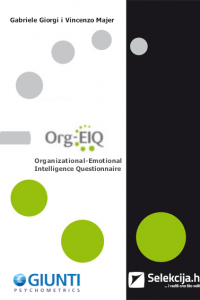

ORGANIZATIONAL-EMOTIONAL INTELLIGENCE QUESTIONNAIRE
In the context of organizational assessments, more and more attention is being paid to the concept of emotional intelligence. The Org-EIQ is an instrument specifically designed to measure emotional competence and organizational intelligence. In general, it relies on research that confirms the wide applicability of emotional intelligence in the workplace and the importance it can have for organizational effectiveness. This instrument consists of four so-called macro factors, which aim to show and describe the emotional skills of an individual. At the same time, they affect aspects of self-awareness and self-evaluation. In other words, by applying the questionnaire, information is obtained about a person’s ability to recognize and classify the emotions they experience at work and evaluate their own internal resources, limitations, and abilities. Also, important data offered by this instrument is the level of self-management of the individual, in terms of their ability to control and regulate their own feelings, moods and impulses. In addition, in a professional context it is important to assess the ability to create social relationships and the empathy that a person possesses and can develop in the workplace. In this regard, the instrument also offers information on the possibility of achieving pleasant communication, cooperation, and leadership skills that the individual is able to demonstrate. The assessment was completed with additional scales, grouping the respondent’s answers into measures of their orientation towards the result, information on mood, tolerance to stress and the ability to create work/life balance. The final interpretation also depends on the dimension of the positive impression. Therefore, within the application of the Org-EIQ instrument, a number of important aspects related primarily to emotional competences in the organizational environment are available.
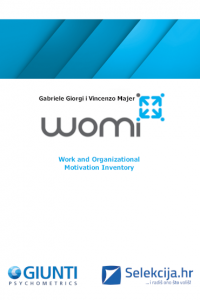

WORK AND ORGANIZATIONAL MOTIVATION INVENTORY
In the work and professional environment, the importance of motivation has been recognized for a long time. The identification of the factors that motivate a person to an activity can largely determine a number of other consequences that are of great importance for both the individual and the organization. The WOMI questionnaire investigates intrinsic and extrinsic aspects, useful both for assessment and for planning and development of human resources. This is an instrument that represents a framework of motivational dynamics that affect the working behavior of an individual and the entire organization. Through 111 statements, it captures key information grouped in the so-called macro factors: Recognition, Success, Expertise and Stability. Examining these broad factors in terms of their narrower dimensions (as many as 18 of them) reveals everything important that can define the rise or fall of someone’s motivation to perform work.
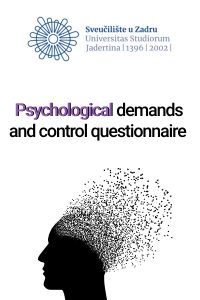

PSYCHOLOGICAL DEMANDS AND CONTROL SCALE
Relying on research and work stress models, Gregov and Šimunić (2012) developed the Scale of Psychological Demands and Job Control. The scale is derived from understanding work stress as the result of continuously experiencing high business demands, with very little control or ability to decide what needs to be done. Through the interaction of these two dimensions of stressors (requirements and control), within Karasek’s model, four stressors are defined. Psychosocial categories of stress at work: active, passive, jobs with low and jobs with high effort. Knowing such job characteristics can be useful in the organizational context and in the effort to understand the work stress of employees. The scale is short, but in psychometric terms it shows adequate indicators of internal consistency, sensitivity, and convergent validity. Considering this, the simplicity of its application and the value of the information it provides make it an instrument of interest in situations that require an assessment of stress at work.


ESCQ – 45
The Emotional Skills and Competence Questionnaire (ESCQ – 45) is an instrument by Professor Takšić from the Faculty of Philosophy in Rijeka, which through 45 statements describes the ability to perceive and understand emotions, the ability to express and label them, and the ability to regulate and manage emotions. It is a high-quality instrument in terms of psychometry, which, due to its applicability and quality, has been translated into numerous world languages; since its first application until today, it has become one of the most commonly used measures of emotional intelligence in our country. From the beginning of the scientific focus on this construct and the initial work on the creation of the instrument until today, prof. Takšić greatly contributed to the understanding and conceptualization of emotional intelligence. Through dedicated work, he first developed a longer form of the instrument (136 statements), which represented a comprehensive measure of the complexly structured model of emotional intelligence by Mayer and Salovey (1997). However, for the sake of practicality and economy, he also constructed two shorter forms of this instrument. One of them is precisely ESCQ – 45, which, given the importance that understanding one’s own and others’ emotional states can have in the context of efficient problem solving and adequate regulation of behavior, has taken an important place in the professional context and organizational assessments.
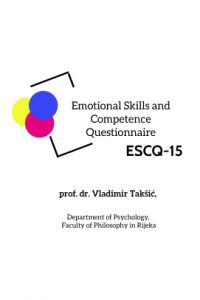

ESCQ-15
The Emotional Skills and Competence Questionnaire (ESCQ – 15) is one of the instruments developed as part of Professor Takšić’s work on understanding and conceptualizing the construct of emotional intelligence. Relying on a broad, comprehensive measure of the complexly structured model of emotional intelligence by Mayer and Salovey (1997), prof. Takšić also designed the UEK-15, as a short one-dimensional instrument. As a questionnaire of practical utility in time-limited assessment situations, it provides a rapid, general assessment of individual differences in emotional intelligence. Due to its adequate reliability and validity, it is a useful and appropriate instrument for situations in which an assessment of emotional intelligence is required, and the practicality of the application itself is a priority.
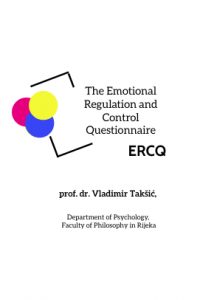

EMOTIONAL REGULATION AND CONTROL QUESTIONNAIRE
The Emotional Regulation and Control Questionnaire (EriC) was created on the basis of scales designed to test the model of emotional intelligence. By researching this construct and developing scales intended to assess its various aspects, prof. Takšić from the Faculty of Philosophy in Rijeka, as part of his dedicated and comprehensive work, ultimately defined a separate scale, focused on the capacity to regulate, and control unpleasant emotions. It is a scale that captures the influence of emotions and mood on memory and thinking and the control of emotional reactions. Through a total of 20 statements aimed at these negative effects of emotions and mood, it captures aspects related to neuroticism, anxiety, and perceived stress.
 English
English



